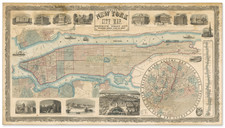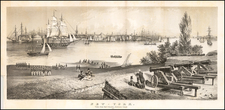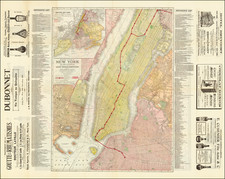Massive Chromolithographed View of New York City
Decorative and detailed panoramic bird's eye view of New York City, drawn by Joseph Klemm and published in Leipzig, Germany, ca. 1908, by F.E. Wachsmuth.
The view – taken as if the viewer were somewhere above Jersey City, New Jersey – shows Brooklyn, Manhattan, the East and Hudson Rivers, Central Park, Governor's Island, Battery Park, Trinity Church, dozens of piers all along the rivers, residential buildings, factories, as well as a large variety of ferries, steamships, and sailing ships at work.
The view is unusually detailed, far more so than many of the views that preceded it in the final forty years of the nineteenth century. The view shows the city only a decade after the amalgamation of New York and Brooklyn created Greater New York City, with the five boroughs we know today: Manhattan, Brooklyn, Queens, the Bronx, and Staten Island.
One the one hand, some of the city looks strange to the modern eye. There are only suggestions of the many skyscrapers that would soon thickly blanket Manhattan. Randall’s and Evans Islands are separate entities divided by Little Hell Gate Channel. The city’s underground subway system had opened only a few years before this view was published, although its immense impact can only be intuited rather than seen here.
On the other hand, many of the notable buildings and landmarks that are still important today were already in operation or just being built when this view was published. For example, in the lower right corner is the Statue of Liberty. The statue itself was a gift of the French people and the passion project of sculptor Frédéric Auguste Bartholdi, with structural input from Gustave Eiffel. It was dedicated on October 28, 1886 after being made and assembled in Paris, then disassembled and transported to New York. The pedestal was created thanks to fundraising by the American people and was designed by Richard Morris Hunt.
Nearby, sticking out of the lower border of the view, is Ellis Island. The island opened as an immigration station in 1892; prior to that, immigrants were processed in Castle Clinton in Battery Park, which is also on this view—more than eight million people entered America through its doors from 1855 to 1890. Ellis Island opened in 1892 and would see twelve million immigrants start their American story there until the island was abandoned in 1955.
This view was printed during the peak of Ellis Island’s operations. Only two years earlier, in 1906, the operation had been expanded from one island to three, and from three acres to 27. The towers of the main building, which housed the massive Baggage Room and the Registry Room, are evident here. This building only opened in 1900, after a fire razed the station to the ground in 1897. The interior was completed only in 1903. One year before this view was likely published, 1907, was Ellis Island’s busiest: 1,004,756 people arrived, with the highest number ever in one day, 11,747, coming on April 7, 1907.
The view is undated, but can be roughly dated by the following clues:
- The Singer Building is shown (built in 1908)
- The MetLife Tower is not shown (built in 1909)
- Shows the Manhattan and Queensboro Bridges, but in a way that makes them appear unfinished (completed 1909)
- The Woolworth Building is not shown (completed 1913)
- Marble Hill is shown as an island (filled in 1914)
The view is not often seen on the market. David Rumsey notes that he acquired his copy from a school in Helsinki, Finland. We also acquired this example in Finland. This is only the second time we have offered this fascinating work.
Josef Ferdinand Klemm was born on Christmas Day 1868 to an Austrian bookseller and publisher, Josef Klemm, and Johanna (née Fessl) Klemm. He was a skilled artist involved in painting, lithography, and image restoration. He specialized in educational murals for schools; these included cityscapes, bird’s-eye views, historical maps, and architectural and monumental plans.











![[ Charleston, Boston, New York, St. Augustine, Bahamas, etc ] Particular Draughts of some of the Principal Towns and Harbours belonging to the English French and Spanish in America and the West Indies.](https://storage.googleapis.com/raremaps/img/small/102804.jpg)

![[Harlem]. Map of the Harlaem Commons surveyed agreeably to the boundaries established by the Commissioners appointed to settle the boundary lines between the common lands of the City of New York and the Town of Harlaem...](https://storage.googleapis.com/raremaps/img/small/59385.jpg)

![Vereinigte Staaten von Nord-Amerika [Views of New York City and Back Country Scenes]](https://storage.googleapis.com/raremaps/img/small/25442.jpg)
